Gaeta
Gaeta
Gaieta | |
|---|---|
| Comune di Gaeta | |
 Gaeta view from sea | |
Saint Erasmus | |
| Saint day | 2 June |
| Website | Official website |




Gaeta (Italian:
The town has played a conspicuous part in military history; its walls date to
Present-day Gaeta is a fishing and oil
History
Ancient times
The ancient Caieta, situated on the slopes of the Torre di Orlando, a promontory overlooking the
In the Republican era Caieta became one of the earliest locations of villae maritimae, seaside
Emperor Antoninus Pius restored the port, given its great strategic relevance.[6] Among its antiquities is the mausoleum of Lucius Munatius Plancus.
The mausoleum of
Middle Ages
At the beginning of the Middle Ages, after the Lombard invasion, Gaeta remained under suzerainty of the Byzantine Empire. In the following years, like Amalfi, Sorrento and Naples, it would seem to have established itself as a practically independent port and to have carried on a thriving trade with the Levant.[3]
As Byzantine influence declined in Southern Italy, the town began to grow. For fear of the
Around 830, it became a lordship ruled by hereditary
The principle of co-regency governed the early dynasties: Docibilis associated John with him, and John, in turn, associated his son Docibilis II with him. In 933, three generations were briefly co-ruling: John I, Docibilis II, and John II. On the death of Docibilis II (954), who first took the title dux, the duchy passed from its golden age and entered a decline marked by a division of territory. John II ruled Gaeta and his brother, Marinus, ruled Fondi with the equivalent title of duke. Outlying lands and castles were given away to younger sons, and thus the family of the Docibili slowly declined after the mid-century.
Allegedly, but improbably, from the end of the 9th century, the
Prince
In 1045, the Gaetans elected their own Lombard duke,
Gaeta, owing to its important strategic position, was often attacked and defended bravely in the many wars for possession of the
In 1227,
King Alfonso V of Aragon (as Alfonso I of Naples) made Gaeta his beachhead for the conquest of the Kingdom of Naples in 1435, besieged it, and to his disadvantage, displayed great generosity by aiding those unable to bear arms which had been driven out from the besieged town. After a disastrous naval battle, he captured it and gained control of the kingdom. He enlarged the castle, which became his royal palace, and created a mint. In 1451 the city was home to the Treaty of Gaeta, stipulated between Alfonso V and the Albanian lord, Skanderbeg: the treaty ensured protection of the Albanian lands in exchange for political suzerainty of Skanderbeg to Alfonso.[11]
Modern era
In 1495, King
In 1528 Andrea Doria, admiral of Charles V, defeated a French fleet in the waters off Gaeta and gave the city to its emperor. Gaeta was thenceforth protected with a new and more extensive wall encompassing Monte Orlando.
In the
On 18 July 1806, the French captured it under
After his flight from the
On 1 August 1849, USS Constitution while in port at Gaeta, received onboard King Ferdinand II and Pope Pius IX, giving them a 21-gun salute. This was the first time a Pope set foot on American territory or its equivalent.
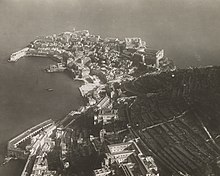
Finally, in 1860, Gaeta was the scene of the
Contemporary age
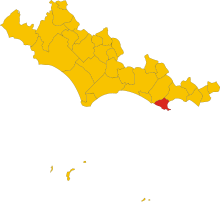
After the
After the king dismissed Mussolini in the summer of 1943, the latter was initially taken via Gaeta to the island prison of
Following the Allied advance across the
Gaeta does have a viable tourism industry, as it is a popular seaside resort. Its warm, rain-free summers attract people to its numerous beaches along the coastline, such as Serapo and Sant'Agostino Beaches. Nearly equidistant to Naples and Rome, Gaeta is a popular summer tourist destination for people from both cities' metropolitan areas.
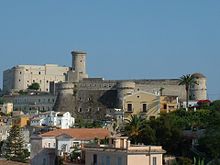

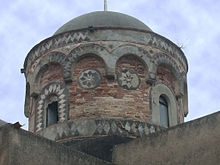
Main sights
The main attractions of the city include:
- The massive Aragonese-Angevine Castle. Its origins are uncertain: most likely it was built in the 6th century, in the course of the Gothic War, or during the 7th century to defend the town from the Lombards' advance. The first documents mentioning it date to the age of Frederick II of Hohenstaufen, who strengthened it in 1233. The current structure is made of two different edifices: the "Angevine" one, in the lower sector, dating to the House of Anjou's rule in the Kingdom of Naples; and the "Aragonese", at the top, built by emperor Charles V, together with the other fortifications that made Gaeta one of the strongest fortresses in southern Italy. The Angevine wing housed a military jail until the 1980s (German war criminal officers Walter Reder and Herbert Kappler were imprisoned here). Now it is a property of the Gaeta municipality, which uses it for conferences and exhibitions. In the dome of the tallest tower is the Royal Chapel, built by King Ferdinand II of the Two Siciliesin 1849.
- The Mausoleum of Lucius Sempronius Atratinus, Mark Antony's fleet commander, has a mausoleum sited in the more recent district of Gaeta: of similar diameter; it is, however not as well preserved.
- The Sanctuary of SS. Trinità, mentioned as early as the 11th century and visited, among the others, by St. Francis and Saint Philip Neri. The Crucifix Chapel was built in 1434 over a rock which had fallen from the nearby cliffs. From the sanctuary, the Grotta del Turco can be visited: it is a grotto which ends directly in the sea and where the waves create atmospheric effects of light.
- Criscuolo. The main altarpiece is an Immacolata by Pulzone.
- San Giovanni a Mare - The church was initially built outside the old sea walls by the hypate Giovanni IV in the 10th century. It combines the basilica form with the Byzantine one. The simple façade has a Gothic portal and a dome, while the interior has a nave with two aisles. The inner pavement is slightly inclined to allow waters to flow away in the case of maritime floods.
- The Cathedral of Assunta e Sant'Erasmo was erected over a more ancient church, Santa Maria del Parco, and consecrated by St. Erasmus, transferred from Formia; the remarkable campanile, in Arab-Norman style, dates from the 12th century. At the base are slabs and parts of columns from ancient Roman edifices.
- The Cathedral has a great bell tower, standing at 57 m, which is considered the city's finest piece of art. The base has two marble lions, and the whole construction largely reused ancient Roman architectural elements. The upper part, octagonal in plan, with small Romanesque arches with majolica decoration, was completed in 1279.
- The Chapel of the Crucifix is a curiosity: built on a huge mass of rock that hangs like a wedge between two adjoining walls of rock. Legend tells how the rock was thus split at Christ's death.
- San Francesco - According to the legend, the church was constructed by the saint himself in 1222. In reality, Frederick II ordered the construction. The church features a fine Gothic-Italian style and hosts paintings and sculptures by many of the most famous Neapolitan artists.[citation needed]
- The parish church of Santa Lucia, the former St. Maria in Pensulis, was once a Royal chapel and here prayed pronaoswith ancient fragments and figures of animals.
- The Medieval Quarter of Gaeta is itself of interest. It lies on the steep sides of Mount Orlando and has characteristic houses from the 11th-13th centuries.
Gaeta is also the centre of the Regional Park of Riviera di Ulisse, which includes Monte Orlando, Gianola and the Scauri Mounts, and the two promontories of Torre Capovento and that of Tiberius' Villa at Sperlonga.
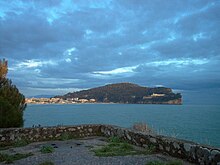
In 1967, the homeport of the U.S. Sixth Fleet flagship relocated from
It is currently used as the home port for the flagship of the United States'
The town is host to the families of the crews who work on the ship. There was a DOD school for American children and the US Naval Support Activity, Gaeta, which provided health care and other services until it was closed down in 2005. The NATO base itself was located on Monte Orlando, which overlooks the Gulf of Gaeta. It has recently been transferred to a shore-based facility where the Commander Sixth Fleet also operates.
Culture
Gaeta has erected a monument to Giovanni Caboto (
Gaetani speak a dialect of Italian that, while similar to the nearby
Distinctive local cuisine includes the
The most famous folklore event of Gaeta is Gliu Sciuscio of 31 December, in which bands of young Gaetani in traditional costumes head to the city's streets, playing mainly self-built instruments.
International relations
Gaeta is
 Cambridge, USA, since 1982[15][16]
Cambridge, USA, since 1982[15][16] Frontignan, France
Frontignan, France Mobile, United States[17]
Mobile, United States[17] Somerville, United States
Somerville, United States Cetinje, Montenegro, since 2012
Cetinje, Montenegro, since 2012 Babolsar, Iran, since 2016
Babolsar, Iran, since 2016
See also
- Diocese of Gaeta
- List of Hypati and Dukes of Gaeta
- Siege of Gaeta
- University of Cassino and Southern Lazio
References
- ^ "Superficie di Comuni Province e Regioni italiane al 9 ottobre 2011". Italian National Institute of Statistics. Retrieved 16 March 2019.
- Istat
- ^ a b c d e Chisholm 1911, p. 385.
- ^ luigi. "Gaeta, dal mito alla storia". B&B a casa di Lidia (in Italian). Retrieved 2021-12-08.
- ^ Cicero, De Oratore 2.22.
- ^ Historia Augusta Antoninus Pius 8.3
- ^ Thomas Robert Shannon Broughton, The magistrates of the Roman Republic, vol. 2, New York, American Philological Association, 1951-52 p 385
- ^ Silvia Bullo, Provincia Africa: le città e il territorio dalla caduta di Cartagine a Nerone, Roma, L'Erma di Bretschneider, 2002, ISBN 978-88-8265-168-8.
- ^ Martial Epigrams V 1
- ^ De ceremoniis Archived 2006-06-19 at the Wayback Machine
- ISBN 99927-1-627-4
- ^ Yachtmedfestival.com Archived 2010-04-23 at the Wayback Machine
- ^ Globalsecurity.org
- ISBN 978-90-04-19466-3.
- ^ "A Message from the Peace Commission: Information on Cambridge's Sister Cities," February 15, 2008. Retrieved 12 October 2008.
- ^ Richard Thompson. "Looking to strengthen family ties with 'sister cities'", The Boston Globe, October 12, 2008. Retrieved 12 October 2008.
- ^ "Online Directory: Alabama, USA". SisterCities.org. Archived from the original on 2007-12-18. Retrieved 2007-11-17.
Sources
- This article incorporates text from a publication now in the public domain: Chisholm, Hugh, ed. (1911). "Gaeta". Encyclopædia Britannica. Vol. 11 (11th ed.). Cambridge University Press. pp. 384–385.
 This article incorporates text from a publication now in the public domain: Herbermann, Charles, ed. (1913). "Archdiocese of Gaeta". Catholic Encyclopedia. New York: Robert Appleton Company.
This article incorporates text from a publication now in the public domain: Herbermann, Charles, ed. (1913). "Archdiocese of Gaeta". Catholic Encyclopedia. New York: Robert Appleton Company.
External links
- Gaetanet.it, all on Gaeta
- All on medieval Gaeta (in Italian)
- Gaeta.it
- Heraldica.org - Napoleonic heraldry
- Links for further development
- Photos 2006


